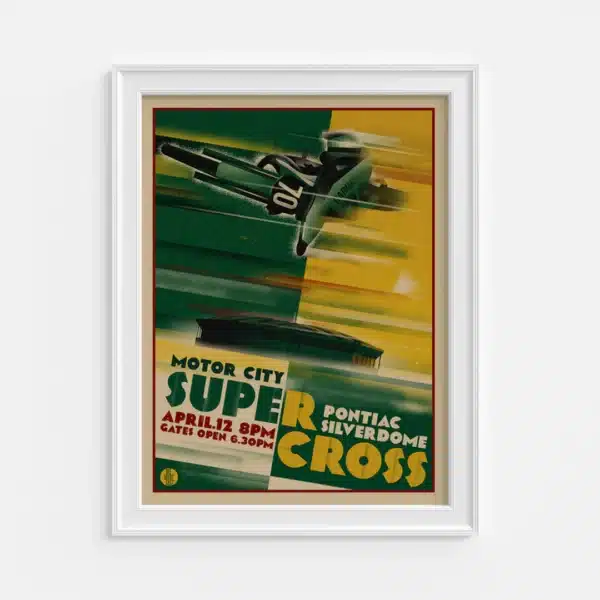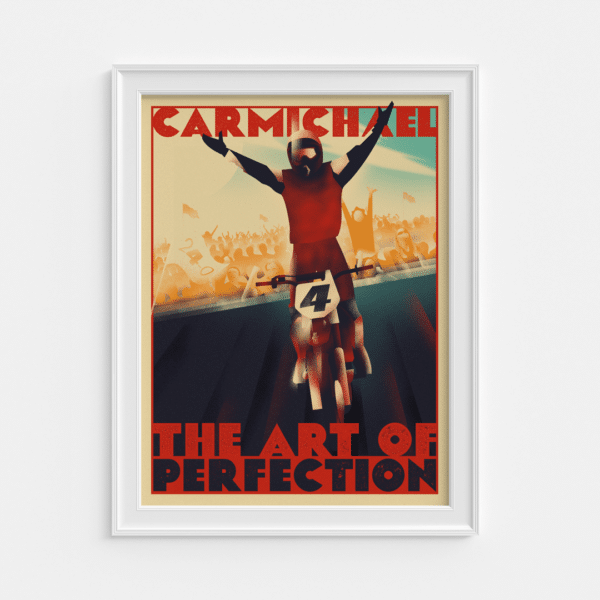The Most Expensive Photo in Motocross History
By
In the spring of 1997, a mysterious 4×6-in. snapshot of Ricky Carmichael showed up in Oakley’s marketing department. Nobody knew who took the photo, yet it became a key marketing asset.
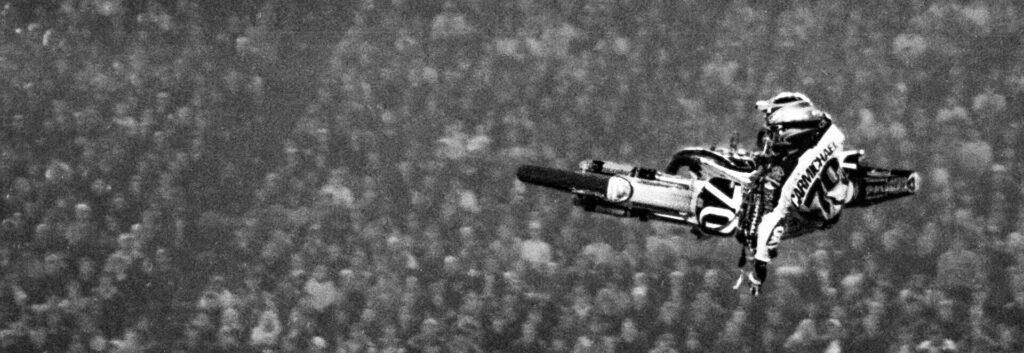
With a camera slung over his shoulder, David St. Onge walked down an arena hallway looking for something to shoot, something worthy of a magazine’s cover. At least that was the dream goal. St. Onge had press credentials for his first professional race, round six of the 1997/98 PJ1 Arenacross Series in Hampton, Virginia.
He didn’t get a cover that weekend, however, not even an inset photo. Instead, on his walk, he found something even more unexpected; one of his photographs already on the cover of a magazine.
Although black and white and cropped, it was unmistakably a photo of Ricky Carmichael that he captured nine months earlier from the seats of the 1997 Pontiac Supercross, the very first stadium race he ever attended. Still 15 feet away from the vendor’s magazine rack, he froze and stared.
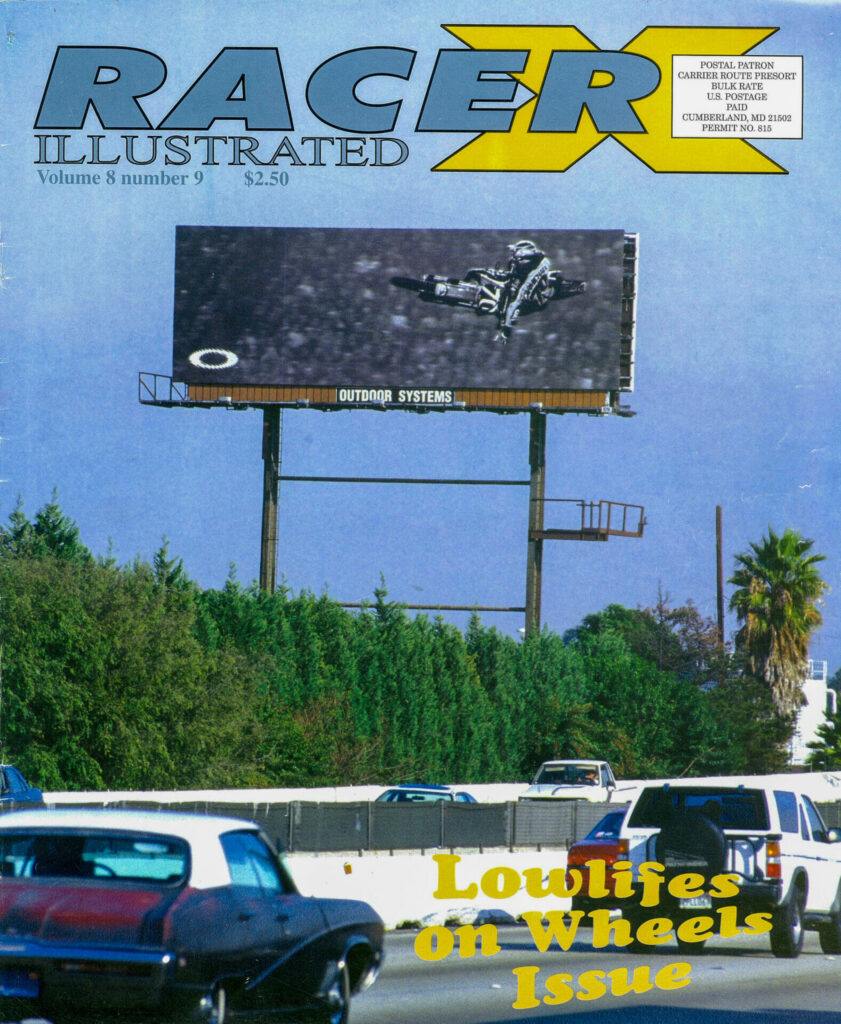
Other than the hundreds of blurry bodies seated in the background, the only subject was 17-year-old Carmichael on a KX125. His bike looked so flat a layman wouldn’t be able to tell a motorcycle was even in the picture. The front wheel turned ever-so-slightly upward. The left end of the handlebar stabbed at the ground and Carmichael’s arm stretched out so far he appeared to be losing his grip.
He looked calm in the air; his head and torso twisted to the right, revealing the name and number on his jersey and a black goggle strap with the recognizable elongated “O” logo of Oakley. In a loud, chaotic, dirty and often brutal sport, this photo represented complete serenity. Behind Carmichael was nothing but crowd, yet their shades of gray more resembled paintbrush strokes or a close-up of a sonogram than people.
St. Onge approached the rack and pulled out the title, Racer X Illustrated. The hair on his arms stood up, he felt his face get hot and his head spin trying to process the thoughts. His photo wasn’t really on the cover. The cover was a photo of his photo, which was… is that an Oakley advertisement? It that a billboard?
David St. Onge was a one hit wonder and nobody knew his name.
Better Late Than Never
St. Onge didn’t ride his first motorcycle until his late 20s, around 1995. “I was terrible, but I really enjoyed it,” he said. “I had too much fear to be a good racer.” He fell in love with motocross and followed the sport on ESPN. A self-employed audio engineer/producer from Ransomville, New York (north of Buffalo) he became interested in photography shortly after discovering dirt bikes.
For Christmas 1996, he bought his wife a Canon Rebel G, a prosumer grade 35mm camera, yet he found himself using the gear more than she did. He absorbed the knowledge in the manuals and trade journals, studied the technical aspects of the equipment and craft, and practiced every chance he got.
In April 1997 he cut through Canada to attend the Pontiac Supercross. He brought along the camera, a 75-300mm telephoto lens and four to five 36-exposure rolls of Kodak Royal Gold 1000 speed film. He shot along the railing during afternoon practice but spent the evening in the lower bowl of the Pontiac Silverdome shooting from his seat. He believes it was the 17th row.

At the end of the second 125cc heat race, St. Onge followed Carmichael through the viewfinder as he approached the finish line and–click–took exactly one photo of the kid in the air. Laying the bike flat after a heat race win summed up Carmichael’s rookie season; completely unpredictable. “Man, I think I might have got something there,” St. Onge thought to himself. “I think I might have got a good shot.”
Carmichael remembers the whip. The Pontiac course looked more like a rough motocross track and he can still see the ruts up the face of the finish. “I’m lucky that I didn’t wreck,” he said. “I landed and I’m like, ‘I can’t believe I pulled that off.’”
A few days later, St. Onge sat in his car in the parking lot of a Tops grocery store. He flipped through the stack of developed color 4×6 prints, the first images he ever shot of an event. He didn’t have the critical eye of a seasoned artist. He still had genuine excitement for all of his photos. But then he stopped at the Carmichael shot. “Okay, that’s pretty cool,” he said to himself in the parking lot.
The Shot of a Lifetime
The photo is perfectly timed; Carmichael is at peak pancake, the exact mid-point of his whip. The original (and uncropped) version has, depending on personal aesthetic tastes, more visual clutter. Carmichael is still the focus but there’s so much else to see.
The crowd is more discernible; facial expressions can’t be read but actions can. Everyone sat at ease, focused on Carmichael. The white hole of a flashbulb in the upper left corner indicates at least one other fan captured this exact moment as well.
The bottom half of the photo is the stadium floor filled with piles of dirt and frumpy looking haybale covers. Four of the five flaggers craned their necks to look up at Carmichael. One offered him the ‘hang ten’ gesture. A photographer aimed his lens upward but not at a steep enough angle to shoot the winner.
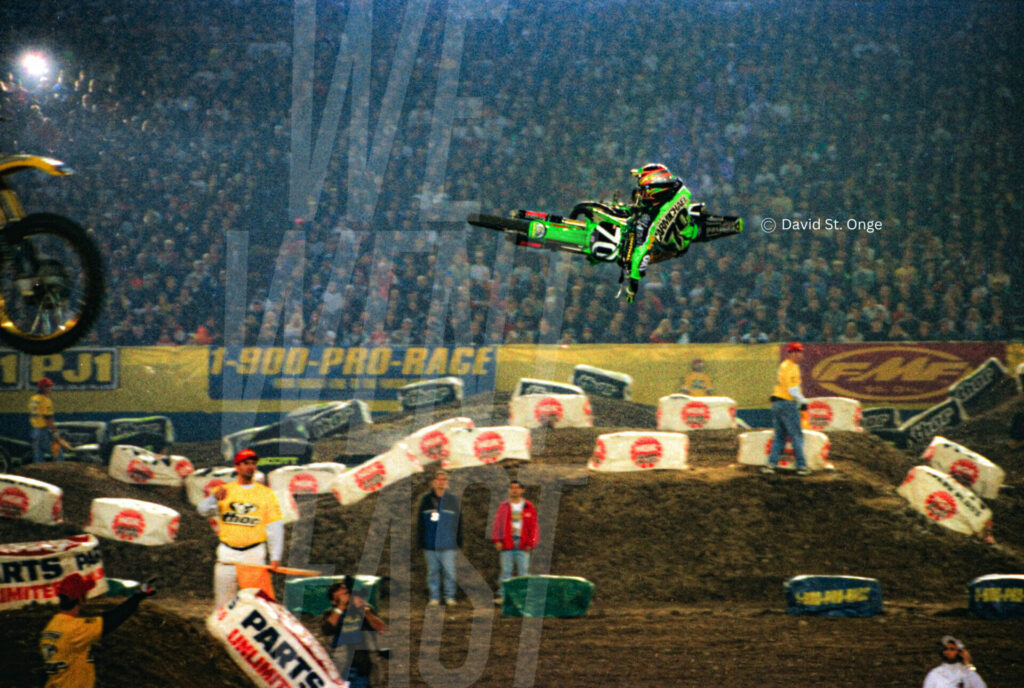
Two men in jackets and jeans–who seem to have no role at all–stood inches off the course, their hands at the sides, their necks tilted back. The man in the blue jacket looks like Kevin Windham’s mechanic, Alley Semar, but even he can’t say for sure.
The front fender and wheel of a Suzuki invaded the left edge but it’s impossible to tell whose bike; eleven Suzukis lined up for heat two that night.
The treatment Oakley gave the photo produced a much more emotional response but the original is still a shot to be proud of. “I got home and showed anybody that wanted to listen. But that was about the extent of it,” St. Onge said.
St. Onge already had plans to attend the next race in Charlotte prior to taking the Carmichael photo at Pontiac. He stuffed a small album full of his prints and now had an excuse to interact with the riders. He got feigned excitement in North Carolina.
“Oh, that’s nice,” St. Onge remembers the riders saying to him. “Most of them were crap in hindsight,” St. Onge said. He saw Carmichael last and when he handed over the print to have autographed, the teenager lit up.
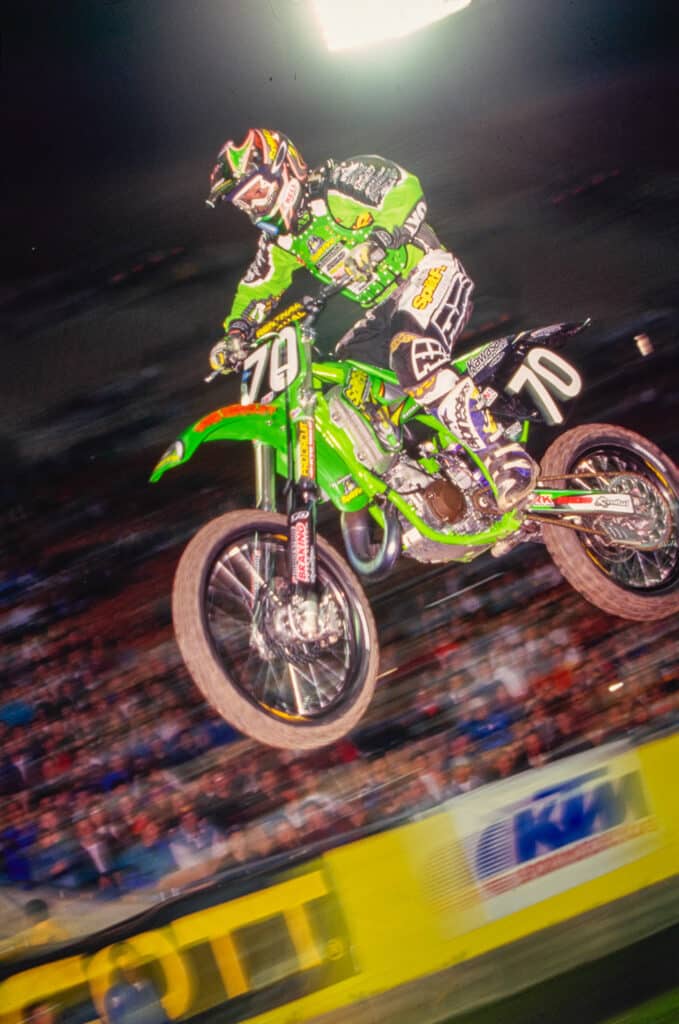
“[He] says, ‘Hey, dude, will you sign this picture for me?’” Carmichael said. “I said, ‘Dude, that’s awesome!’” Instead of signing it, Carmichael asked if he could keep it. St. Onge couldn’t believe it and he immediately obliged the request. They had a brief conversation and he walked away. But a few minutes later he felt a sense of remorse for not leaving his contact information with Carmichael.
Maybe he could get an autographed photo in exchange. He returned with his name, address and phone number on a business card or slip of paper. Carmichael had already left, and he gave the info to Chad Watts, Carmichael’s mechanic. When reached via text message, Watts said he does not remember this moment from Charlotte 1997.
“I know 1,000% I gave all my contact information to Chad,” St. Onge said. “What Chad did with it, I have no idea. I’m not trying to put any blame on him.” St. Onge shot from the seats in Charlotte but didn’t leave with anything memorable. He returned to New York, printed a new copy of the Carmichael photo from the negative and immersed himself more into both riding and shooting.
I know 1,000% I gave all my contact information to Chad
–David St. Onge
A Mystery Photo Arrives at Oakley
Carmichael won the race in Charlotte on April 19, 1997, the third victory of his rookie season. At some point that day he showed the photograph to Johnny O’Mara and asked the 1984 AMA Supercross champ to take it back to Oakley and make color photocopies on regular 8.5 by 11-in. paper.
O’Mara, the motorcycle racing sports marketing manager at Oakley was also Ricky’s trainer and coach; he came to every race. Carmichael laughs about how corny this sounds today but he literally just wanted something to tape up in his bedroom. “I think he brought me back, like, ten [copies] and I just put one on my wall and, hell, that’s it, really.”
O’Mara remembers seeing the photo but he doesn’t remember bringing it back to Oakley’s headquarters in Irvine, California. He agrees that he’s the only logical person who could have been the photo’s mule in 1997. “I remember just going, ‘Damn, that’s sick.’ Those were my words,” O’Mara said thinking about his initial reaction to the image. “You shake your head how impressive he was on a motorcycle, even in his first year on the bike.”
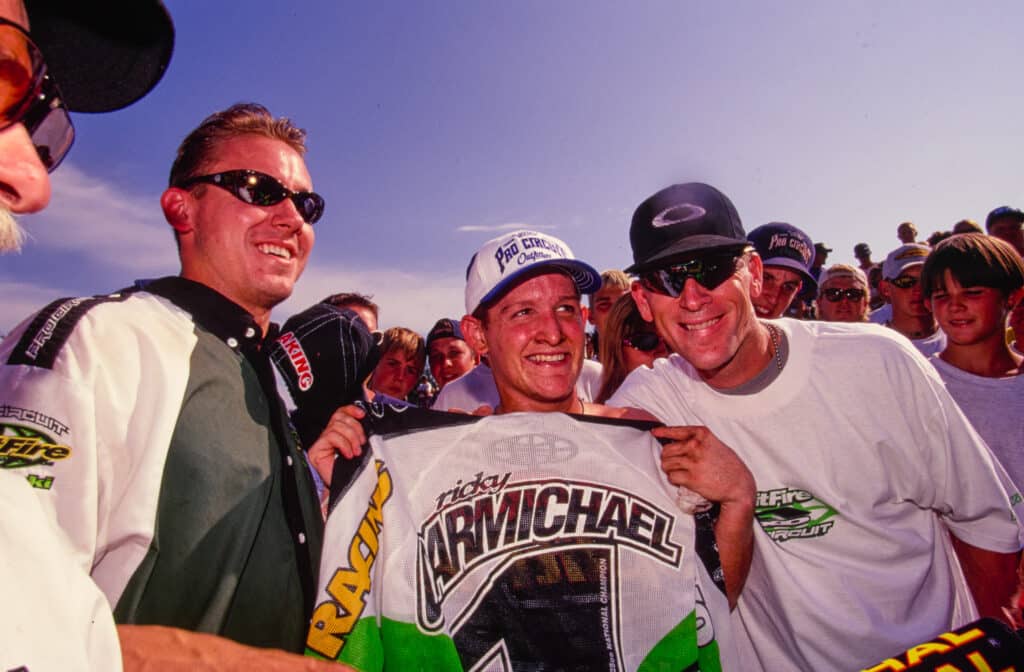
O’Mara reported to two people at Oakley: Louis Wellen, the director of sports marketing and Scott Bowers, the vice president of sports marketing.
“We were all, like, awing over it, looking at it in the office,” Bowers said. “I think even a little bit of the roughness added to it. It wasn’t a typical photoshoot shot where you get the perfect resolution, the perfect color.”
Nobody remembers the original color version of the photo, the 4×6-in. Kodak print that O’Mara brought back. Not even Tom Moyer, the founder and creative director of M1, then the exclusive advertising design agency for Oakley, remembers the color photo.
Moyer and his team created the Oakley ‘look’ that was applied to hundreds of photos for athletes in dozens of sports, “this high contrast, black and white manipulated image with the backgrounds blurred,” Moyer said. Moyer’s team added motion to emphasize the athlete and movement. In the Carmichael photo, specifically, softening, darkening and blurring the crowd created an illusion he referred to as “atmospheric perspective.”
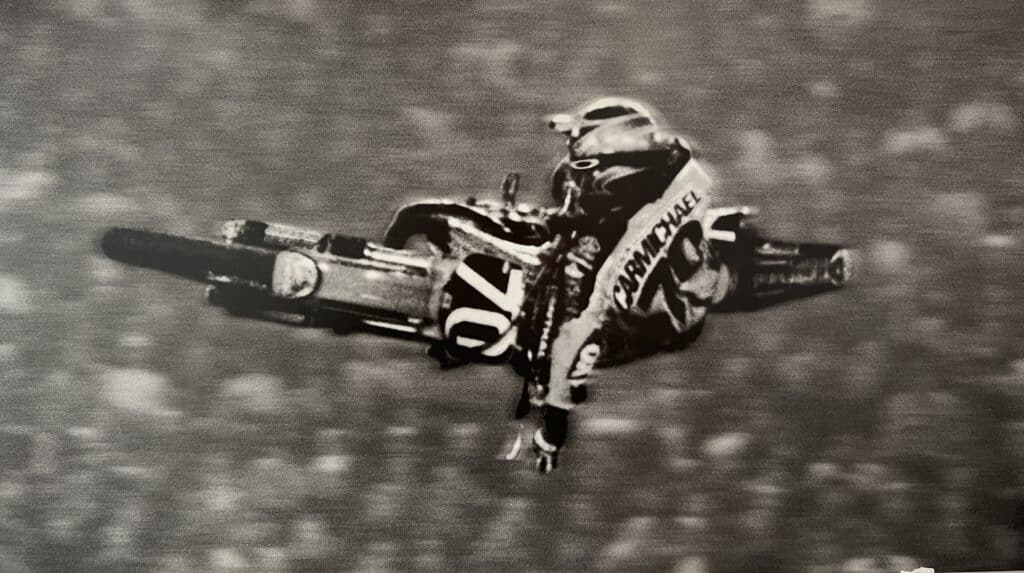
“We wanted to enhance what was already there,” he said. “It’s a very powerful image. One of the things that we really tried to do was make sure that any time anyone saw a piece from Oakley they knew it was Oakley right away, almost even without the logo they knew.” After treatment, Moyer would have submitted a proof to Oakley for a first round of edits.
“I remember seeing that photo taped to cubicles,” Wellen said. “Anyone that was a motorcycle head at Oakley had a Xerox copy of it.” Oakley’s marketing department knew they didn’t have an agreement from the photographer.
They couldn’t find him.
They asked Carmichael and O’Mara, who shrugged. Davey Coombs, founder of Racer X Illustrated got a phone call from Oakley and saw the photo before it became part of Oakley’s ad campaign. He had no info but as a photographer and publisher, the composition and angle struck him.
RC @ Pontiac Print
“I think we’ve all grown to love this photo, but when I first saw it I think my thought was, ‘Cool whip, but how did he get that angle?’” Coombs said. “That’s when it became sort of this Zapruder film of motocross. It wasn’t who got shot or who fired the gun – it was who shot the photo? When you have a floor pass for supercross you’re usually shooting up at a guy when he’s in the air, or you’re shooting him tight in a corner.”
In this image, however, the photographer seemed to float in the air with the subject. Perspective holds weight and St. Onge’s photo, with its perfect straight-on shot angle, the ground cropped out and blurry onlookers, the subject appears to be in a state of infinity on all sides.
I loved it as soon as I saw it. I made the call to use it for multiple things, including a poster. Really don’t remember much about it other than I loved the shot.
–Oakley Founder, Jim Jannard
“I loved it as soon as I saw it,” said Oakley Founder, Jim Jannard in an e-mail. “I made the call to use it for multiple things, including a poster. Really don’t remember much about it other than I loved the shot.”
Bowers and Wellen both said that, despite being a public company by 1997, Oakley still had a ‘small’ feel and Jannard oversaw the major design and marketing decisions. “I could see Jim saying, ‘Let’s run with it and if we have to, we’ll beg for forgiveness if the photographer comes forward,’” Bowers said.
The iconic (and now very rare) Oakley poster went into production first. When, exactly, is unclear, but certainly at some point in the second half of 1997. The eight former Oakley employees I spoke with can’t recall exact timelines or production runs.
Bowers said an average poster run started at 5,000 but this one, being segmented for motocross, could have been as few as 1,500. Oakley dealers received them as gifts from their field representatives. A two-page version of the photo appeared as an advertisement in the 1998 AMA Supercross program, the only small format print version of the image.
BENCH RACING
In the 1997 125 East Supercross Championship, which rider won two of the first three rounds and led the championship?
How the image wound up on a billboard is its own story. In 1997 Oakley had space on I-405, the Los Angeles area freeway notorious for its traffic (according to a 2012 Humboldt State University study, the entire 72 miles of 405 saw average annual daily traffic of between 245,000 and 354,000 automobiles).
Today, this specific billboard on 405 South (near LAX) garners one million impressions per week, according to Outdoor Media, owners of the space. Renting the 14-ft. tall by 48-ft. wide placard now costs over $50,000 for a four-week campaign. Oakley had the billboard locked up in a multi-month campaign and that fall they used it to promote a Kevlar material used in the company’s first footwear product, Shoe One. The ad, according to Bowers, featured a hypodermic needle dripping with Kevlar and copy ‘O Type Positive’.
“We received so much hate mail,” Bowers said. “This was also somewhat at the height of the AIDS epidemic and bad use of needles. So, we immediately pulled it down and we couldn’t think of an image to run.”
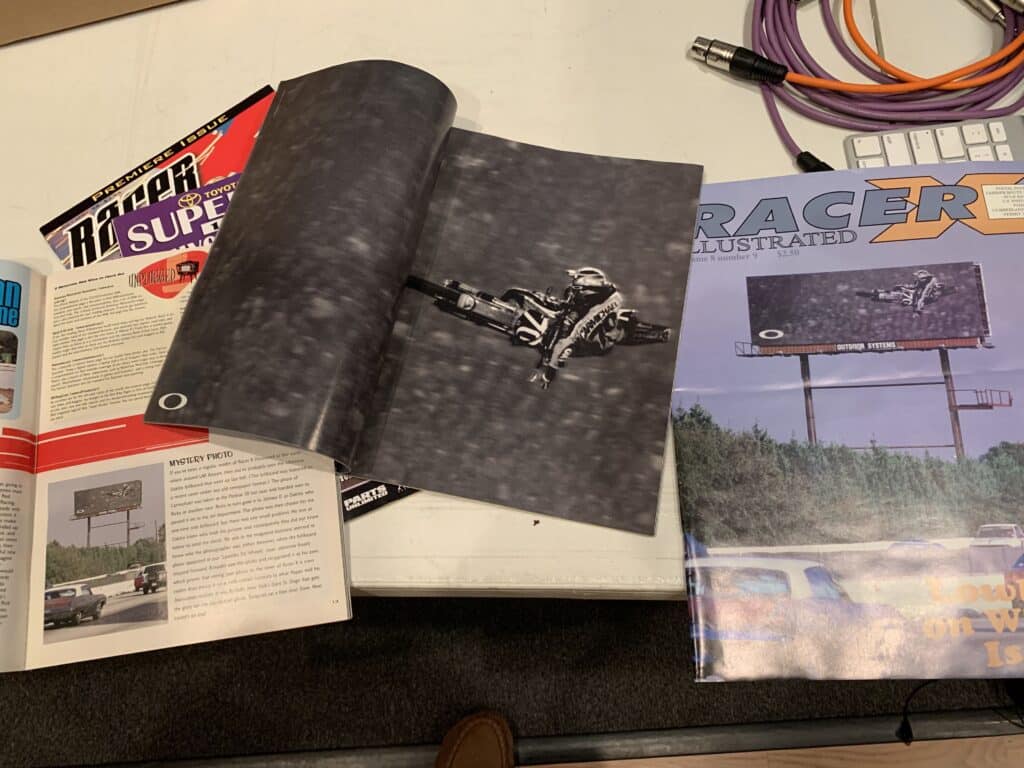
Urgently in need of a replacement, someone suggested the Carmichael photo, taken by the photographer nobody could find. What is more astonishing here? That a ticketholder’s photograph–a regular 4×6-in. print, probably covered in fingerprints by the time it reached the art department–could be become a 672 square foot advertisement? Or that a motocross rider soared high above one of the busiest freeways in the entire world?
The timing was perfect. The image went up late in the fall. The 1998 Supercross series began on January 10 at the LA Memorial Coliseum, 14 miles away. “We thought, it’ll blow people away,” Bowers said. “It’ll be very cutting-edge for motocross in general, especially for us to do something as rebellious as that image and only locking it up simply with an O, not even calling out Oakley.”
It impressed Carmichael, who didn’t know about it. O’Mara picked him up at LAX when he came to California for off-season training or testing. Rounding a bend on 405 O’Mara said, ‘Hey Ricky, look at that!’. Carmichael, 18 at the time, could only muster a ‘Holy crap!’ before the monster-sized version of himself whizzed out of view.
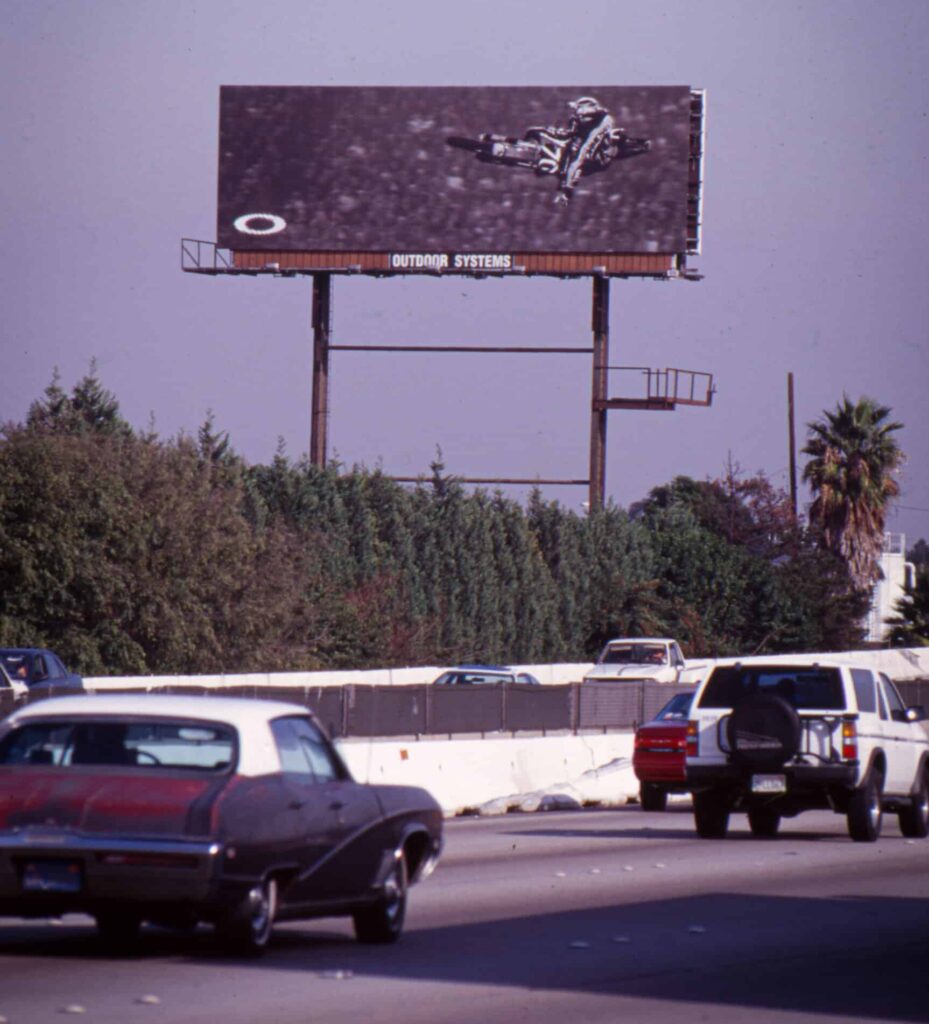
Coombs needed an image for issue number nine/volume eight of his Racer X Illustrated newspaper and when he found out about the billboard he asked contributor Chris Hultner to get him a photo of it. Hultner pulled over to the shoulder, jumped out of the car, snapped one photo across the 10 lanes of traffic and left. The issue shipped by the end of the year.
Meanwhile, in Ransomville, David St. Onge discovered he’d been published in the February 1998 issue of Motocross Journal, a now-shuttered sister publication of Motocross Action. A larger-than-half-page color photo of Kevin Windham at the 1997 Binghamton Motocross National–a photo he took from the spectator’s side of the fence–appeared on page 79.
Legends Series: Ricky Carmichael
The editors spelled his name incorrectly (David St. ‘Once’), a small but cringe worthy injustice. It was his first published photo. Or so he thought. He didn’t get paid, but the editor agreed to secure press credentials to any east coast race he wanted to attend. Between 1998-2000 he estimates he attended around 15 races and always sent in his slides. He never got another photo published.
His first race as a credentialed photographer? The Arenacross in Hampton, Virginia, January 16-18, 1998.
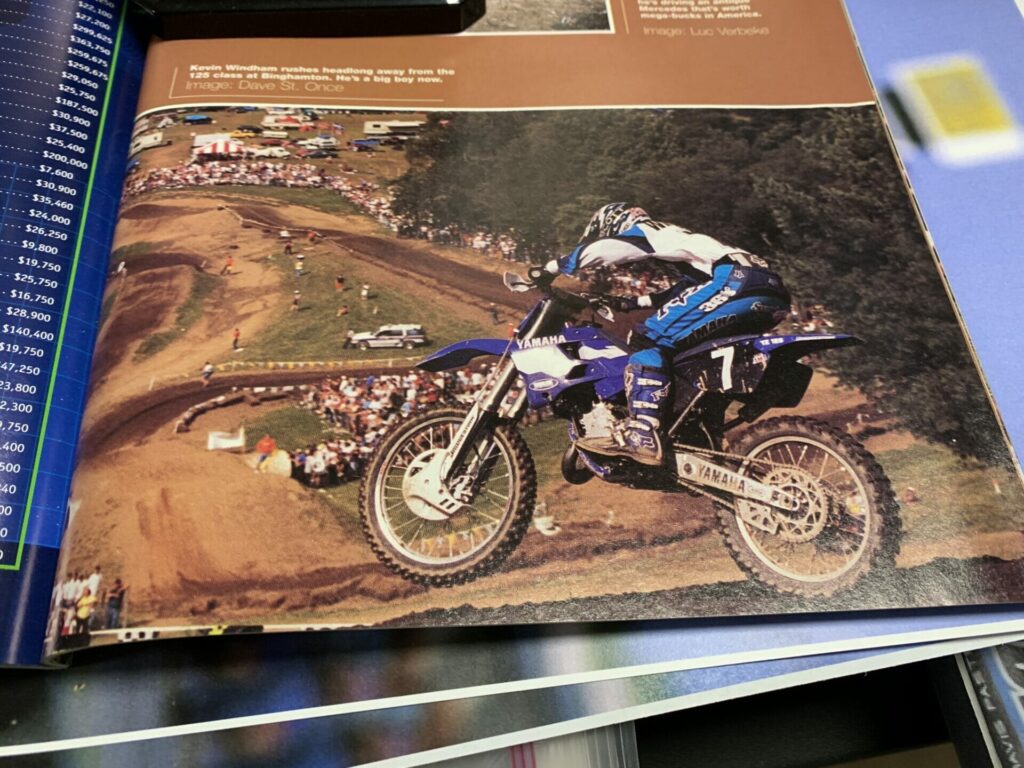
“I’m Sure Oakley Has a Check For You”
When St. Onge returned home from Virginia he logged on to Oakley.com. Bam! The entire screen filled up with a photo of Ricky Carmichael. His photo! On Monday morning, January 19, 1998, he called Racer X and talked to Coombs who remembers being asked what he thought the photo was worth. “I can remember thinking a thousand dollars, maybe two thousand,” Coombs said. “I remember him saying, ‘It’s got to be ten thousand’ or something like that.”
St. Onge vividly recalls Coombs telling him “I’m sure Oakley has a check for you,” and that he would contact Oakley on his behalf. In the meantime, a client of St. Onge’s recommended a lawyer; he called the lawyer, who said (provided St. Onge has negatives and a true story )it’s an open/shut case. St. Onge said he wanted to give Oakley a chance to call back first.
So now I’m getting pissed. I’m trying to get a career started.
–David St. Onge
He spent three full, agonizing days reflecting, stewing. In that time, he also discovered the run of posters with Oakley’s copyright along the edge. He couldn’t get the one hit wonder analogy out of his head and his angst grew.
“So now I’m getting pissed. I’m trying to get a career started. Man, what a way to start it with this photo, right? But nobody knows I shot it. To me, this is a big deal. Maybe [Oakley is] busy. It’s not a big deal to them. But right now, this was my whole world.”
He waited until the morning of Thursday, January 22 and called the lawyer back to proceed. The lawyer told him to register the photo with the Library of Congress ASAP. An Oakley representative finally called that afternoon. He can’t remember a name but he told the woman it was too late, that he’d decided to handle it with a lawyer. A former Oakley legal counselor declined to comment, citing attorney/client privilege. Why Oakley took three full days to call St. Onge back remains a mystery. One theory assumes they were cleaning up.
Oakley to Field Reps: “Get the Posters Back”
When Scott Taylor, an Oakley field representative, received a box of approximately 150 Ricky Carmichael posters, he was asked to quickly get them in the hands of all his dealers in Florida. In early 1998, he got another urgent memo: ‘get the posters back.’ “I remember driving around my territory at 100 mph and peeling out of parking lots,” Taylor said. “Nobody was giving those things up. They became gold.” Taylor made sure the walls of his dealers were clean but he only got back a small handful of the posters, mostly from non-moto resellers.
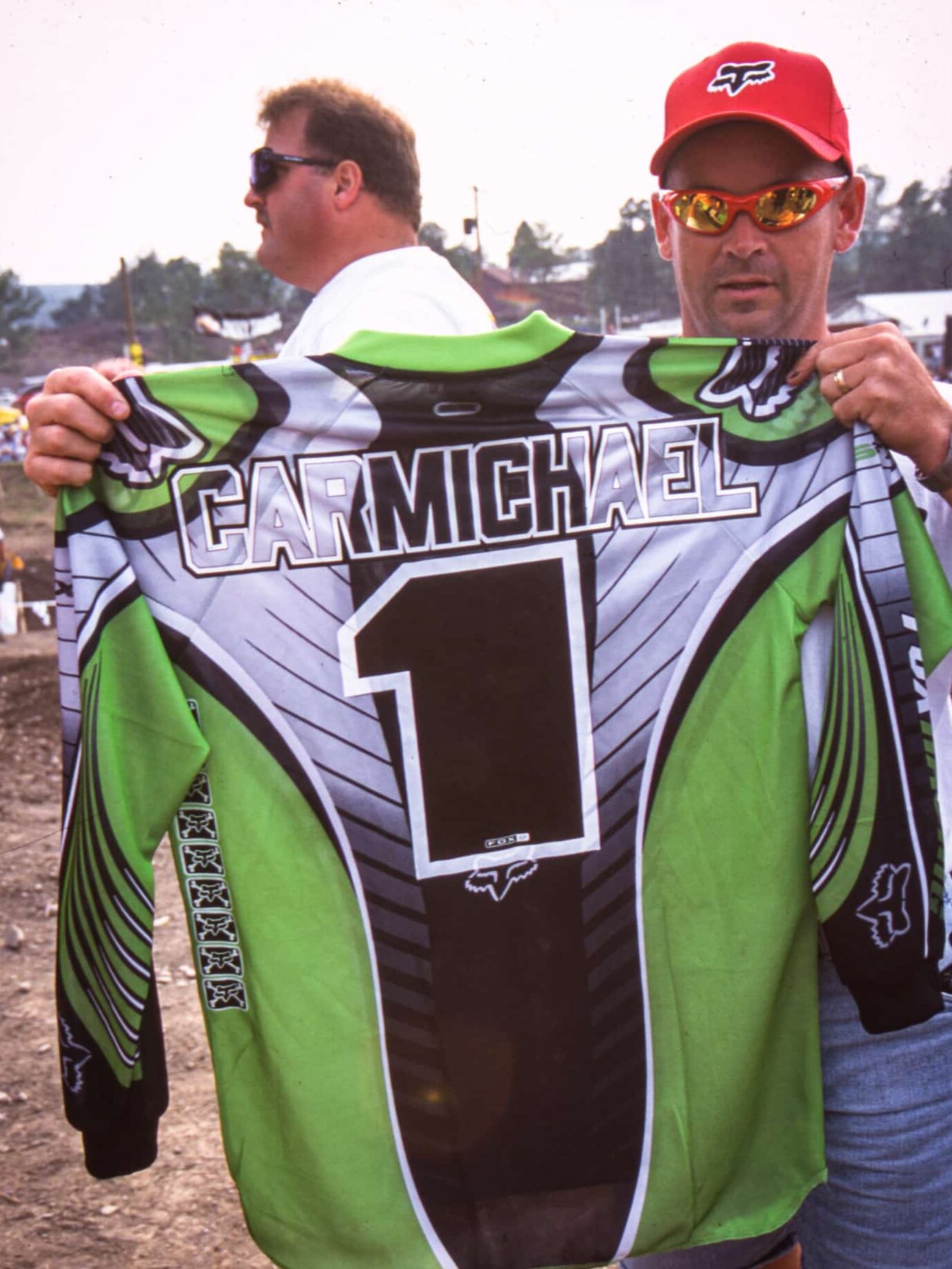
On the I-405 billboard in Southern California, Michael Jordan replaced Carmichael.
When St. Onge dug in with the lawyer the following week, the case took a bizarre twist; his attorney wanted to go after everyone. St. Onge had visited the University of Buffalo to study copyright law and discovered willful copyright infringement punishable up to $100,000per use. St. Onge counted four uses: the poster, the 1998 supercross program, Oakley’s website and the billboard.
But he wondered, is each of those considered one use? Or is each poster printed considered one use? The lawyer said that was up to a judge to decide and said, “That’s why we want to sue everybody, including Ricky, Kawasaki, Pontiac Silverdome…” and, of course, Oakley.
St. Onge balked and said absolutely not. “The only people that did anything wrong here was Oakley,” he told the attorney. A week later the lawyer said they didn’t want to litigate it, that Oakley wasn’t a big enough company.
“I remember him specifically saying ‘the size of McDonald’s’ then it would be worth going out and litigating it. Let’s face it. They’re f—ing gold-diggers, right? Because he knew the more they could get off a judgement, the more they’d make.”
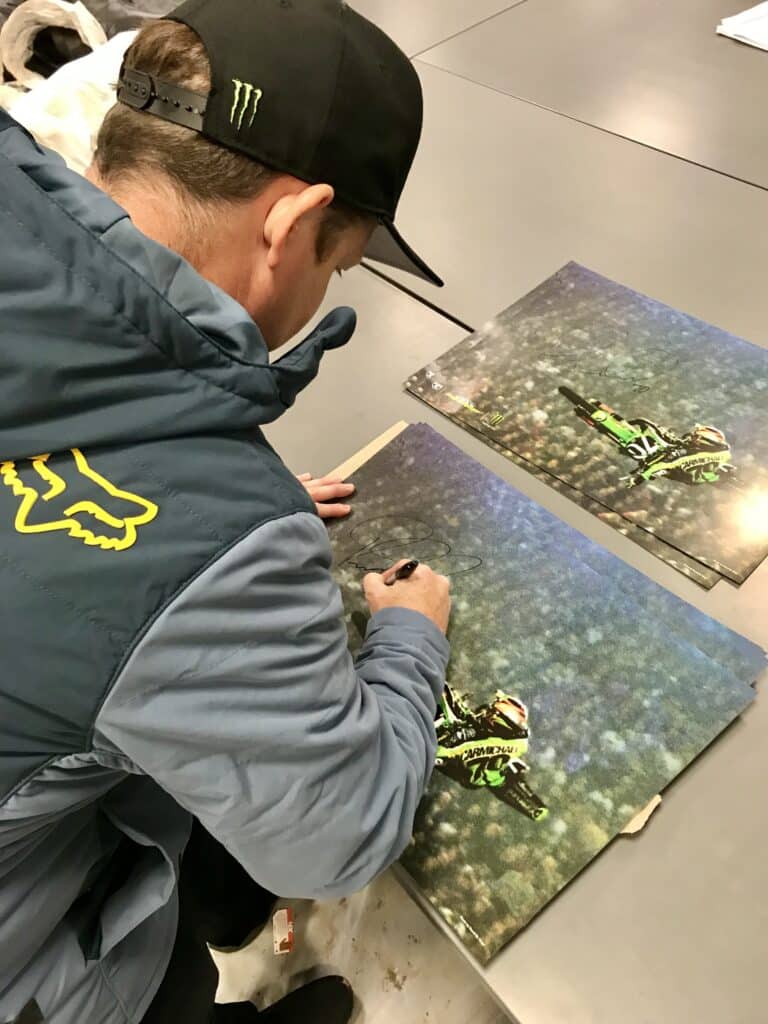
The big lawsuit against Oakley over a mystery photograph never happened. That’s an urban legend. St. Onge bristles when he hears people refer to it as ‘The most expensive photo in motocross history’. It gives the illusion of a lucrative payday and a future spent on Easy Street. He settled out of court for “low five figures” and politely declined to say exactly how much. The lawyer took a third.
Wellen said he knew Oakley had spent $15,000 to purchase global rights for other images used in a similar fashion. St. Onge admits that, had Oakley been able to find him before using the photo, he wouldn’t have had the guts–or the experience–to negotiate too hard. He would have gladly taken $1,000.
Motocross on a billboard in LA was (and still is) a big deal. Factor in the settlement, the legal fees, the entire ad campaign, billboard space, printing and distribution costs and the 1997 Carmichael photo is a six figure image. It undoubtedly is the most expensive photo in dirt bike racing history and one that Moyer is still particularly proud of. He said, of the hundreds of photos he worked on for Oakley, the Carmichael shot received a lot of feedback. “That was a very successful image,” he said. “That was one of the better ones. I want to thank [St. Onge] for the image because we had a lot of fun working on it. I’m glad that it still has power and still speaks to people.”
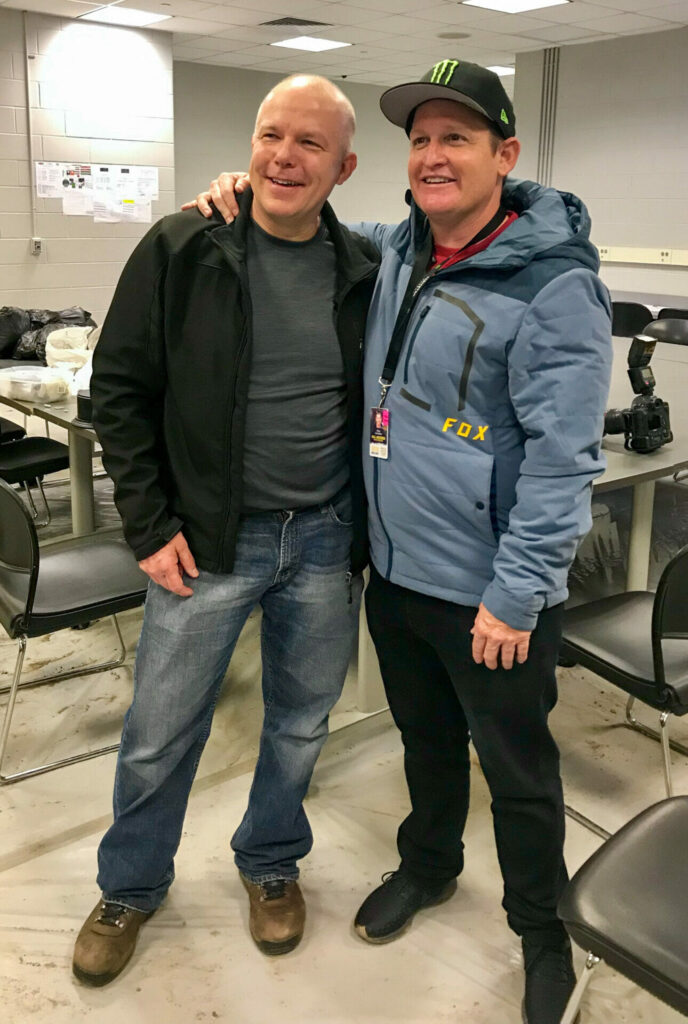
“Technically, it’s a piece of s@#!”
The settlement finished within six to eight weeks and St. Onge used the money to buy a full-frame Canon EOS-3 and a variety of lenses. He continued to shoot at select races with press credentials. Pat Schutte, the public relations director for PACE Motor Sports in 1998, liked to introduce St. Onge with a punchy prelude; “This is the guy who shot the Carmichael photo.”
St. Onge became a cult figure in the small pool of regular photographers and Schutte recalls them all being on his side. Joe Bonnello, a particularly witty lensman, had the most succinct and honest line of all when he said, “Technically, it’s a piece of s—. Aesthetically, it’s a masterpiece.”
After failing to gain traction as a motorcycle photographer, St. Onge attended his last race in 2000 and focused on his recording business, which continues today. He had trepidation about telling this story, even though it’s more than two decades in the distance. “My fear was people would see the actual photo and be let down,” he said.
My fear was people would see the actual photo and be let down.
–David St. Onge
He couldn’t be more wrong. Until now, the original version had never been published and only a small handful of people ever saw it. It’s like he opened up a time capsule, you know, the one we all buried on the playground in the fifth grade? We all get to drift back to the late 1990s.
For motocross fans, it’s a mystery solved, a special treat, a tale finally told. Today we’re inundated with so many photos that our thumbs never stop moving. There’s a story behind every photo but not every photo has a story.
If you’d like to read more about the 1997 Pontiac Supercross, specifically, check out this story: The Moment: The 1997 Pontiac Supercross.
